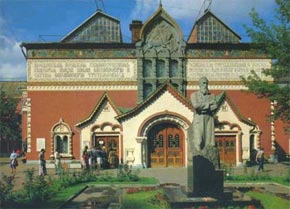 INTRODUCTION
INTRODUCTION

The State Tretyakov Gallery is one of the largest and oldest
collections of fine arts in Russia and has a world-wide significance.

The Gallery was started in the 19th century by the Moscow
merchant Pavel Tretyakov. The foundation of the Gallery as a national public
museum of Russian art became his life's goal and work. In 1892, Pavel Tretyakov
presented the City of Moscow with his collection which comprized about two
thousand works, together with the mansion it was housed in and the adjacent
garden. After the death of Pavel Tretyakov the creation of his hands and soul
continued to live and develop. The collection was steadily growing. The
citizens of Moscow as well as of other Russian cities presented or sold to the
Gallery works of art preserved at their homes as family relics. The preceding
and subsequent generations of the Gallery's staff members would search for and,
more often than not, saved from destruction the works by great and undeservedly
forgotten Russian artists. They had in mind the creation of a retrospective
panorama of national fine art reflecting its century-old evolution.

The Tretyakov Gallery has become one of the most famous
museums where true masterpieces of national art are exhibited to the general
public. Its collection comprizes more than one hundred thousand items.

The path to the Mansion of Tretyakov will never get overgrown
with grasses of oblivion: it is hard to find a Russian who, at least once,
would not have visited the Gallery which is situated in a quiet lane at
Zamoskvorechye. By order of President of the Russian Federation the Gallery was
officially recognized as one of the most significant establishments of national
culture.

Like every museum the State Tretyakov Gallery posseses a
collection that is an integral whole united by an original conception. The loss
of even one work, not to mention part of the collection, may result in
irretrievable losses for the museum as well as for the whole of Russia's Museum
Fund, reflecting the multinational culture of this country.

The collection of the Tretyakov Gallery was preserved and
saved in the turbulent years of the Bolshevik Revolution (1917), during the
turmoil of the Civil War and the dramatic 1930s with the earnest efforts of the
government as well as of the Gallery's staff, dedicated to their work. The
beginning of the war between Germany and the USSR in June, 1941, and the fast
penetration of the Nazi troops deep into the country set the government and the
museum staff the immediate task to save the collection. They urgently began to
pack the works of art. The precious brittle cargo was sent beyond the Urals by
two trains.

In the end of May, 1945, the Tretyakov Gallery opened its
doors again with usual hospitality. Yet, not all of the works survived in the
ordeals of the war of 1941-1945, part of the collection has disappeared. That
is how it happened: during the period from 1930 to 1937, by order of the
Committee on Arts the Gallery had to hand over in temporary use its thirty
eight works to the Embassies of the USSR in Germany, Austria, Czechoslovakia
and Poland. The paintings, most of them dating from the 18th, 19th and early
20th century were meant to decorate the interiors of the Embassies. The
practice of decorating interiors of state offices with museum exhibits is wrong
and vicious but the staff members of the Museum can hardly be blamed for doing
so during the terrible 1930s when disobedience might have threatened death.

Immediately on the return from the evacuation the Gallery
started the search for all that had been lost. When the Gallery inquired about
the destiny of the pictures that had been previously handed over, the Ministry
of Foreign Affairs of the USSR reported that in 1945 they did not discover any
works of art in the former embassies of the USSR abroad, the works of art
should be considered as captured during the Nazi occupation or as destroyed in
the course of military operations. This answer makes it obvious that they did
not make any attempts to search for the lost works of art at that time.
According to the order of the Committee on Arts at the Soviet of Ministers of
the USSR the thirty eight paintings have been written off the state inventory
and excluded from the Gallery's collection.

Thus, the Gallery has been forever deprived of its inimitable
originals, such as Blind Beggars at the Market in Malorossia by V. Makovsky,
Winter Evening and Rye Stacks by N. Dubovskoi, and Pines above the Precipice by
I. Shishkin - all of them bought by Pavel Tretyakov. These pictures once made
part of the 'gold reserves' of the Gallery as well as a rare 18th-century piece
The House of Pashkov in Moscow. At the same time the famous series of works by
L. Borisov made at the Samoyed settlements in the North of the country and
later bought by Pavel Tretyakov as an entire collection, is now incomplete.
Nevertheless, as is generally known, "manuscripts never perish in flames".
There are numerous examples in the world museum practice when works of art the
whereabouts of which remained unknown for decades, could suddenly come to light
in the most inexplicable and mysterious way. Perhaps our paintings do survive
and await their opportune moment to get returned to their home, to the good old
mansion of Pavel Tretyakov.
Chief Curator of the State Tretyakov Gallery
L. Romashkova

